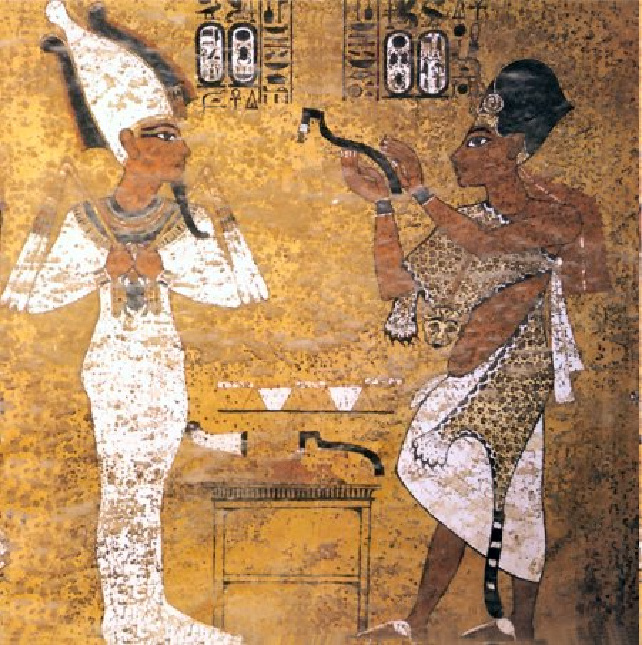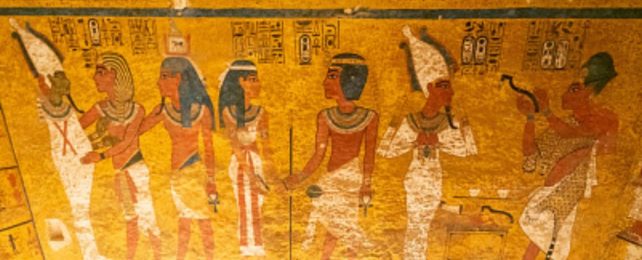This year marks the 100-year anniversary of the discovery of Tutankhamun's tomb, and, even after all this time, the famous burial site is still revealing its secrets and stirring up controversy.
A renowned British Egyptologist and former British Museum curator claims to have found evidence that the tomb's royal murals and hieroglyphics might have been a hasty cover-up.
Nicholas Reeves has argued for years now that the painting of Tutankhamun on his tomb's wall is not actually of the pharaoh himself. The lines around the corner of his mouth are often seen in paintings of his predecessor, Nefertiti.
Reeves, therefore, thinks that before the images on the walls depicted a 19-year-old male's burial, they might have shown Tutankhamun burying his step-mother, Nefertiti, whose mummy has never been found.
According to a new interview with Reeves, the oval-framed hieroglyphs above these depictions, known as cartouches, appear to have been written over, changing the identity of those involved in the burial ceremony.
Historically, researchers thought the mural of the 'opening of the mouth' ceremony (below), depicted Tutankhamun's body being prepared for burial by his successor, Ay.

But Reeves says Ay's features, including his chubby chin and snub nose, are more reminiscent of a young Tutankhamun.
"Close inspection of Ay's cartouches reveals clear, underlying traces of an earlier name – that of Tutankhamun," Reeves told The Guardian.
"In its original version, this scene had shown Tutankhamun performing the funerary ritual for the tomb's original owner, his immediate predecessor … Nefertiti."
According to Reeves, it's entirely possible that Tutankhamun's tomb was tacked onto what was originally Nefertiti's tomb, following the boy king's unexpected death.
If Reeves is right, then it adds weight to the theory that Nefertiti may be buried close by.
In fact, Reeves has been arguing for years now that Tutankhamun's tomb is more suited to a queen than a king.
First of all, the tomb is unusually small – the smallest of all the royal tombs in the Valley of the Kings. The treasures found within are also, according to Reeves, 'feminine' in nature.
What's more, the floor plan is skewed compared to other tombs, and the murals appear to have been put together in a hurry, with signs that the paint had not yet dried when it was sealed.
Together, this suggests the burial was a rushed affair, and that makes sense, as Tutankhamun was still in his late teens when he died.
Perhaps the pharaoh's unexpected death required some improvisation from those alive more than 3,000 years ago. The burial site originally meant for Tutankhamun may not have been finished yet, and may instead have been used for his successor, Ay.
In 2015, researchers working in Tutankhamun's tomb found some features on the wall, barely discernible with the human eye, that looked as though they might indicate the presence of a hidden, sealed off chamber nearby.
Reeves has put these lines of evidence together and argued that Nefertiti's body lies in one of those chambers.
Others, like Egypt's antiquities minister, Mamduh al-Damaty, disagree.
They argue that if hidden chambers exist, which is still hotly debated, they might hold the body of Tutankhamun's probable biological mother, and not that of Nefertiti.
In 2018, radar scanning of Tutankhamun's tomb showed no signs of connecting chambers. But then, in 2020, another scan of the site suggested there may be a secret enclosure nearby after all.
There's only one way to know for sure. But given the priceless nature of this site, knocking down a bunch of walls is not exactly a well-received proposition.
For now, Reeves' theory remains speculation.
